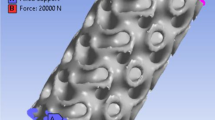The physicochemical stability of the composite system consisting of hydroxyapatite (HAP) including 10, 25, and 50% polyethylene glycol (PEG) with a molecular weight of 400 in different physiological solutions has been studied. In the interaction of HAP + PEG 400 composite systems with physiological solutions, the amount of Ca in the filtrate changes versus the PEG content of the composite and the salt composition of the reaction media. The rate of calcium release in Ringer and Ringer–Lokk solutions, whose chemical composition is close to that of the tissue fluid of living organisms, is almost twice as high as in a 0.9% NaCl solution. Chemical analysis has shown that the HAP +10% PEG 400 composite system interacts with physiological solutions and is likely to promote calcium interchange between the experimental material and tissue fluid. Infrared spectroscopy has demonstrated that polyethylene glycol is present in the HAP + 10% PEG system over 120 h of interaction with biological media of living organisms, which will promote the restoration of nervous impulses in the treatment of bone defects. The HAP + 10% PEG 400 composite system can be recommended for further study in the development of novel composite materials for rehabilitation orthopedics.



Similar content being viewed by others
References
C. Delgado, G. Francis, and D. Fisher, “The uses and properties of PEG-linked proteins,” Crit. Rev. Ther. Drug Carrier Syst., 9, No. 3–4, 249–304 (1992).
K. W. Sexton, A. C. Pollins, N. L. Cardwell, et al., “Polyethylene glycol rapidly restores axonal integrity and improves the rate of motor behavior recovery after sciatic nerve crush injury,” J. Surg. Res., 177, No. 2, 392–403 (2012).
L. L. Hench, “Bioactive implants,” Chem. Ind., 14, 547–550 (1995).
J. M. Britt, J. R. Kane, C. S. Spaeth, et al., “Polyethylene glycol rapidly restores axonal integrity and improves the rate of motor behavior recovery after sciatic nerve crush injury,” J. Neurophysiol., 104, No. 2, 695–703 (2010).
W. Suchanek and M. Yoshimura, “Processing and properties of hydroxyapatite-based biomaterials for use as hard tissue replacement implants,” J. Mater. Res., 13, No. 1, 94–117 (1998).
T. Kanazawa, Inorganic Phosphate Materials, Materials Science Monographs, Elsevier, Amsterdam (1989).
A. A. Krylov, A. M. Kats, and A. S. Kantorovich, Guideline for Clinical Diagnostic Laboratories [in Russian], Meditsina, Leningrad (1981), p. 212.
Yu. A. Pentin and L. V. Vilkov, Physical Research Methods in Chemistry [in Russian], Vysshaya Shkola, Moscow (1987), p. 367.
Author information
Authors and Affiliations
Corresponding author
Additional information
Translated from Poroshkova Metallurgiya, Vol. 57, Nos. 5–6 (521), pp. 128–133, 2018.
Rights and permissions
About this article
Cite this article
Boshytska, N.V., Protsenko, L.S., Budilina, O.N. et al. Physicochemical Stability of Hydroxyapatite–Low-Molecular Polyethylene Glycol 400 Composite Systems in Biological Media. Powder Metall Met Ceram 57, 349–352 (2018). https://doi.org/10.1007/s11106-018-9990-0
Received:
Published:
Issue Date:
DOI: https://doi.org/10.1007/s11106-018-9990-0




